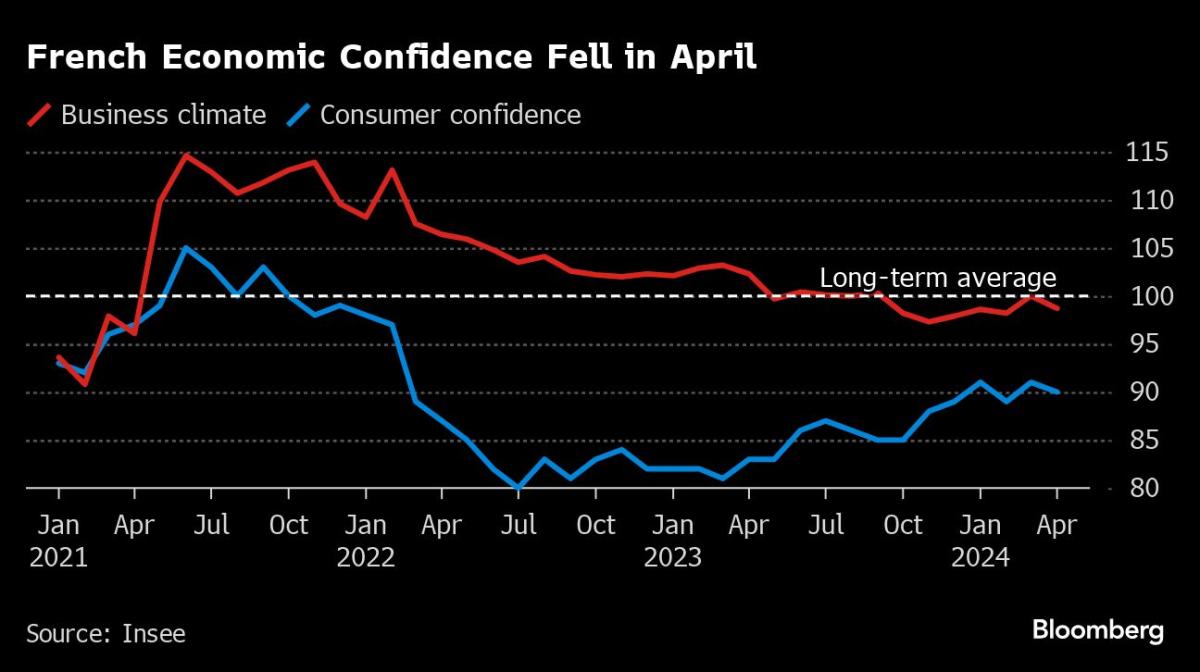
French economic growth in the first quarter of the year rose by 0.2%, surpassing analysts' expectations of 0.1% expansion, indicating a potential exit from a mild recession in the euro area. Germany is also showing signs of recovery from a similar economic slump, with the European Central Bank expected to initiate monetary easing in June to further support the region. Additionally, Lithuania experienced a GDP expansion of 0.8% in the first quarter, with growth expected to strengthen in the second half of 2024 fueled by rising consumer sentiment and domestic consumption.

The Eurozone managed to avoid a recession as its GDP growth stabilized in the fourth quarter of 2023, according to preliminary data released by Eurostat. The bloc's GDP grew by 0.5% for both the euro area and the European Union as a whole, preventing a technical recession. However, the growth rate is in contrast to the 3% growth seen in the US, putting pressure on the European Central Bank (ECB) to consider interest rate cuts. Germany and France, the heavyweights of the Eurozone, experienced declines in GDP but managed to avoid a recession.

The US economy experienced a slowdown with a GDP growth rate of 1.6% in the first quarter of 2022, lower than the predicted 2.4%. Despite this, consumer spending on services remains strong, while spending on goods like cars and gasoline declined. Speculation surrounds the Federal Reserve's potential interest rate cuts due to recent inflation increases, with only 6.4% of investors expecting a rate cut in May. The International Monetary Fund raised its 2024 growth forecast for the US to 2.7% due to robust employment and consumer spending.

China's GDP grew 5.3 percent year-on-year in the first quarter of this year, up 1.6 percent from the fourth quarter of last year, showing China's economy is on a solid footing for continued recovery, which will further enhance international expectations for China's development prospects. A series of international financial institutions such as the Asian Development Bank, Goldman Sachs and Morgan Stanley recently raised their forecasts for China's economic growth this year. A report released by the Asian Development Bank anticipates China will contribute 46 percent to the economic growth of developing countries in Asia this year and the next, and will remain the largest contributor to global economic growth.

The European Central Bank left interest rates unchanged but reduced its growth and inflation forecasts, with concerns about high domestic inflation. ECB President Christine Lagarde indicated a potential rate cut around June due to strong inflation and poor economic data. The eurozone's headline inflation eased to 2.6% in February. The ECB also lowered its growth forecast for the year. Lagarde emphasized the need for evidence of declining inflation, and financial markets anticipate a rate cut in June. Lagarde mentioned pressure to improve Europe's capital markets but resisted calls to confiscate Russian central bank assets.

This article includes a lists of countries and dependent territories sorted by their real gross domestic product growth rate; the rate of growth of the value of all final goods and services produced within a state in a given year. The figures are from the International Monetary Fund World Economic Outlook Database unless otherwise specified.This list is not to be confused with the list of countries by real GDP per capita growth, which is the growth rate of GDP per person recalculated according to the changing number of the population of the country.

Stocks, including the Dow Jones Industrial Average, S&P 500, and Nasdaq Composite, fell significantly following the US economy's subpar growth in the first quarter. Meta (formerly Facebook) experienced a 14% drop in its stock as a result of weaker-than-expected revenue and increased AI spending. IBM, Caterpillar, and Microsoft led the Dow's decline, while Merck, Coca-Cola, and Apple saw gains. The US GDP for 2024 Q1 rose by 1.6%, lower than the expected 2.4%, marking the seventh consecutive quarter of growth but below the previous quarter's rate of 3.4%.

This is an alphabetical list of countries by past and projected gross domestic product (nominal) as ranked by the IMF. Figures are based on official exchange rates, not on the purchasing power parity (PPP) methodology. Values are given in millions of United States dollars (USD) and have not been adjusted for inflation. These figures have been taken from the International Monetary Fund's World Economic Outlook (WEO) Database (October 2023 edition) and/or other sources.For older GDP trends, see List of regions by past GDP (PPP).

GDP (PPP) means gross domestic product based on purchasing power parity. This article includes a list of countries by their forecast estimated GDP (PPP). Countries are sorted by GDP (PPP) forecast estimates from financial and statistical institutions that calculate using market or government official exchange rates. The data given on this page are based on the international dollar, a standardized unit used by economists. Certain regions that are not widely considered countries such as Hong Kong also show up in the list if they are distinct jurisdiction areas or economic entities.GDP comparisons using PPP are arguably more useful than those using nominal GDP when assessing the domestic market of a state because PPP takes into account the relative cost of local goods, services and inflation rates of the country, rather than using international market exchange rates, which may distort the real differences in per capita income. It is however limited when measuring financial flows between countries and when comparing the quality of same goods among countries. PPP is often used to gauge global poverty thresholds and is used by the United Nations in constructing the human development index. These surveys such as the International Comparison Program include both tradable and non-tradable goods in an attempt to estimate a representative basket of all goods.The first set of data on the left columns of the table includes estimates for the year 2023 made for each economy of the 196 economies (189 U.N. member states and 7 areas of Aruba, Hong Kong, Kosovo, Macau, Palestine, Puerto Rico, and Taiwan) covered by the International Monetary Fund (IMF)'s International Financial Statistics (IFS) database. The data is in millions of international dollars and was calculated and published by the IMF in October 2023. The second table includes data, mostly for the year 2022, for 180 of the 193 current United Nations member states as well as Hong Kong and Macau (the two Chinese Special Administrative Regions). Data are in millions of international dollars; they were compiled by the World Bank. The third table is a tabulation of the CIA World Factbook GDP (PPP) data update of 2019. The data for GDP at purchasing power parity has also been rebased using the new International Comparison Program price surveys and extrapolated to 2007. Non-sovereign entities (the world, continents, and some dependent territories) and states with limited recognition (such as Kosovo, Palestine and Taiwan) are included in the list in cases in which they appear in the sources. These economies are not ranked in the charts here, but are listed in sequence by GDP for comparison. In addition, non-sovereign entities are marked in italics.

The European Central Bank (ECB) chief, Christine Lagarde, insists that discussion of interest rate cuts is premature, despite concerns over Germany's struggling economy. Lagarde acknowledged that the eurozone likely stagnated in the final quarter of 2023. Meanwhile, a German business survey flagged recession fears, and a UK poll showed a recovery in consumer confidence. The ECB has left interest rates on hold at 4%. Inflation remains above the 2% target, and the bank is cautious about signaling future easing. The US, in contrast, saw stronger-than-expected growth in Q4 2023, fueling hopes of controlling inflation without economic downturn.

Eurozone inflation eased to 2.8% in January, down from 2.9% in December, in line with market expectations, fueling hopes for an early European Central Bank (ECB) interest rate cut. The drop in inflation was attributed to lower energy prices. The underlying picture also improved, with core inflation (excluding food, alcohol, tobacco, and energy) at its lowest in nearly two years. However, services prices, which indicate wage pressures, remained steady at 4%. ECB officials have expressed the need for solid wage growth to cut interest rates. Eurozone employment data showed stable unemployment rates in December.

Gross domestic product (GDP) is the market value of all final goods and services from a nation in a given year. Countries are sorted by nominal GDP estimates from financial and statistical institutions, which are calculated at market or government official exchange rates. Nominal GDP does not take into account differences in the cost of living in different countries, and the results can vary greatly from one year to another based on fluctuations in the exchange rates of the country's currency. Such fluctuations may change a country's ranking from one year to the next, even though they often make little or no difference in the standard of living of its population.Comparisons of national wealth are also frequently made on the basis of purchasing power parity (PPP), to adjust for differences in the cost of living in different countries. Other metrics, nominal GDP per capita and a corresponding GDP (PPP) per capita are used for comparing national standard of living. On the whole, PPP per capita figures are less spread than nominal GDP per capita figures.The rankings of national economies over time have changed considerably; the United States surpassed the British Empire's output around 1916, which in turn had surpassed the Qing dynasty in aggregate output decades earlier. Since China's transition to a socialist market economy through controlled privatisation and deregulation, the country has seen its ranking increase from ninth in 1978, to second in 2010; China's economic growth accelerated during this period and its share of global nominal GDP surged from 2% in 1980 to 18% in 2021. Among others, India has also experienced an economic boom since the implementation of economic liberalisation in the early 1990s.The first list includes estimates compiled by the International Monetary Fund's World Economic Outlook, the second list shows the World Bank's data, and the third list includes data compiled by the United Nations Statistics Division. The IMF definitive data for the past year and estimates for the current year are published twice a year in April and October. Non-sovereign entities (the world, continents, and some dependent territories) and states with limited international recognition (such as Kosovo and Taiwan) are included in the list where they appear in the sources.

The European Central Bank is expected to use its Thursday meeting as a precursor to an interest rate cut in June as central banks worldwide consider easing credit due to receding inflation. Market indexes dropped in the U.S. following a higher-than-expected inflation report, sparking concerns that the Federal Reserve might delay rate cuts. ECB President Christine Lagarde hinted at a potential rate cut in June, waiting for sustained evidence of controlled inflation after a decrease to 2.4% in March from a peak of 10.6% in October 2023. Investors are eager to see how Lagarde's news conference will guide future rate movements.

This is a list of U.S. states and territories by gross domestic product (GDP). This article presents the 50 U.S. states and the District of Columbia and their nominal GDP at current prices.The data source for the list is the Bureau of Economic Analysis (BEA) in 2022. The BEA defined GDP by state as "the sum of value added from all industries in the state."Nominal GDP does not take into account differences in the cost of living in different countries, and the results can vary greatly from one year to another based on fluctuations in the exchange rates of the country's currency. Such fluctuations may change a country's ranking from one year to the next, even though they often make little or no difference in the standard of living of its population.Overall, in the calendar year 2022, the United States' Nominal GDP at Current Prices totaled at $25.463 trillion, as compared to $23.315 trillion in 2021.The three U.S. states with the highest GDPs were California ($3.6 trillion), Texas ($2.356 trillion), and New York ($2.053 trillion). The three U.S. states with the lowest GDPs were Vermont ($40.6 billion), Wyoming ($47.4 billion), and Alaska ($63.6 billion).GDP per capita also varied widely throughout the United States in 2022, with New York ($105,226), Massachusetts ($99,274), and North Dakota ($96,461) recording the three highest GDP per capita figures in the U.S., while Mississippi ($47,572), Arkansas ($54,644), and West Virginia ($54,870) recorded the three lowest GDP per capita figures in the U.S. The District of Columbia, though, recorded a GDP per capita figure far higher than any U.S. state in 2022 at $242,853.

This is a list of the African nations ranked by Gross Domestic Product (GDP) at Purchasing Power Parity (PPP). Figures are given in international dollars according to the International Monetary Fund.The GDP (PPP) of the dependent or integral territories of France, Italy, Malta, Portugal, Spain, the United Kingdom and Yemen within the African continent are not included in this list. For the purpose of the data published by the International Monetary Fund, the GDP (PPP) of Zanzibar is included as part of that of Tanzania, the GDP (PPP) of Western Sahara is included as part of that of Morocco, and the GDP (PPP) of Somaliland is included as part of that of Somalia.

US stocks declined following a below-expectation GDP growth rate of 1.6% for the first quarter, raising concerns about the economy. The Nasdaq fell 0.6%, S&P 500 dropped 0.5%, and Dow Jones slipped 1%. Inflation increased by 3.7%, fueling discussions on the Federal Reserve's interest rate strategy. Meta shares plummeted over 10% due to increased costs, while Google's parent company saw a 10% surge in stock value. Microsoft exceeded revenue projections, boosting its shares by 5%, whereas Intel's shares tumbled 8% on disappointing revenue guidance.

The figures presented here do not take into account differences in the cost of living in different countries, and the results vary greatly from one year to another based on fluctuations in the exchange rates of the country's currency. Such fluctuations change a country's ranking from one year to the next, even though they often make little or no difference to the standard of living of its population.GDP per capita is often considered an indicator of a country's standard of living; however, this is inaccurate because GDP per capita is not a measure of personal income.Comparisons of national income are also frequently made on the basis of purchasing power parity (PPP), to adjust for differences in the cost of living in different countries. (see List of countries by GDP (PPP) per capita). PPP largely removes the exchange rate problem but not others; it does not reflect the value of economic output in international trade, and it also requires more estimation than GDP per capita. On the whole, PPP per capita figures are more narrowly spread than nominal GDP per capita figures.Non-sovereign entities (the world, continents, and some dependent territories) and states with limited international recognition are included in the list in cases in which they appear in the sources. These economies are not ranked in the charts here (except Kosovo and Taiwan), but are listed in sequence by GDP for comparison. In addition, non-sovereign entities are marked in italics.Four UN members (Cuba, Liechtenstein, Monaco and North Korea) do not belong to the IMF hence their economies are not ranked below. Kosovo, despite not being a member of the Unity Nations, is a member of IMF. Taiwan is not a IMF member but it is still listed in the official IMF indices.Note that several leading GDP-per-capita (nominal) jurisdictions may be considered tax havens, and their GDP data subject to material distortion by tax-planning activities. Examples include Bermuda, the Cayman Islands, Ireland and Luxembourg.All data are in current United States dollars. Historical data can be found here.



https://www.theguardian.com/profile/graemewearden,https://www.theguardian.com/profile/larryelliott

Yahoo! News

Yahoo! News

Yahoo! News

PANORA

PANORA

PANORA

PANORA

Wikipedia

PANORA

Wikipedia

Wikipedia

PANORA

PANORA

Wikipedia

PANORA

Wikipedia

Wikipedia

PANORA

Wikipedia